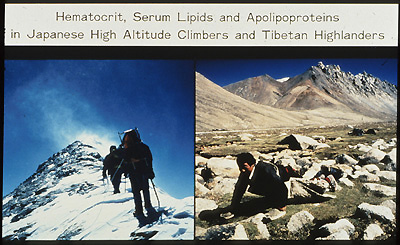| 4. Field Medicine and VerticalGeography: High Altitude Medicine On this globe, people live not only onislands and plains but also in mountainous areas. At an altitude of 5,000meters above sea level, as represented by the Himalayas, the oxygen density ofthe atmosphere is approximately half of that at sea level, and at anextremely high altitude of over 8,000 meters, it is only a third. Even at suchhigh altitudes, many people manage to live, and it has been proven that peoplecan climb to 8,000 meters or higher. How does human physiology change at suchhigh altitudes and in such a low oxygen environment? What happens to therespiratory function, circulatory function and function of the brain. . .? Andhow does it affect the aging of people living at such high altitudes fromgeneration to generation? It is becoming clear that there is little obesityamong those living in high altitude Tibet, but that they tend to age quickly. At presentthere is no medical specialty dedicated to the scientific pursuit of the medicalproblems encountered at high altitudes – one of the limits of humanexistence – and this is also a challenge for field medicine.
MATSUBAYASHI Kozo |
